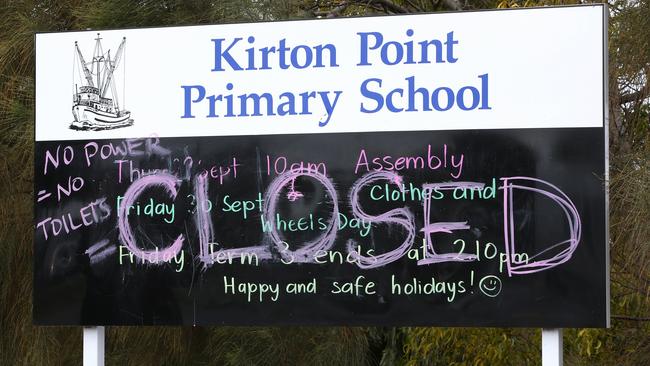Daniel Wills: Premier Jay Weatherill sweats on SA blackout reports as political heat looms
PREMIER Jay Weatherill is winning the early politics of the statewide blackout but, like the original storm that triggered the event, there are dangerous factors outside his control still swirling.
Opinion
Don't miss out on the headlines from Opinion. Followed categories will be added to My News.
- GALAXY POLL: Public sides with Jay on blackout explanation
- EXPLAINED: AEMO’s first major blackout report in plain English
- ANALYSIS: Facts challenge Jay’s blackout spin
- THE REPORT: ‘Multiple faults’ led to SA blackout, report says
- LIKELY: Double warnings of statewide blackouts
PREMIER Jay Weatherill is winning the early politics of the statewide blackout but, like the original storm that triggered the event, there are dangerous factors outside his control still swirling.
This exclusive Advertiser-Galaxy poll was taken after a week of reassurances from Mr Weatherill that the storm was the sole cause of the catastrophe and while the full meaning of a far more ambiguous Australian Energy Market Operator report was still filtering through.
At the time, incredible images of felled electricity towers were front of public mind. This poll shows many people broadly accepted that “this was a weather event, not a renewable energy event”.
As time goes on, there are three technical fronts on which new facts could cause a rethink. If renewables are found culpable on any of them, Mr Weatherill will find himself on far less certain ground.
AEMO isolated three key points in the blackout where the role of renewables is in question and will be probed.
After high-voltage lines in the Mid North came down, six wind farms mysteriously went offline. Treasurer Tom Koutsantonis has attributed this to a “system glitch, a software error” unrelated to wind power itself, with a more complete explanation still expected from independent experts.
After the Victorian interconnector then went down, the surviving wind-dominated element of the SA network lost stable frequency and crashed.
Safeguards were not strong enough to prevent collapse.
As attempts were made to restore the system, two unnamed stations meant to jump-start the network failed to operate properly and SA called on Victoria’s coal-dominated supply for help.
The state faces a frustrating wait for answers. An update is due next week, with hopes a full picture will be painted by AEMO within six months.
Australia’s chief scientist Alan Finkel is also looking from a national perspective at the role of renewables in energy security and the market.
This is likely to be a tense wait for Mr Weatherill, who has no control over either of those reviews but said he is happy to be judged on the results of Labor’s aggressive renewable energy policies.
Already it seems the system did not, as Mr Weatherill told FIVEaa the morning after the storm, “respond in the way in which it was designed to respond”. At the very least, there was a software glitch and failures with restart systems.
But even separately to these reports, the broader merits of that fidelity to wind power will be tested in the coming months as summer time rolls around. It will be the first summer since the carbon dioxide-belching stacks of the Port Augusta power station were turned off in May. As we step into this unknown territory, the consequences of a new energy mix will begin to show.
There have been worrying predictions from experts like Deloitte and Frontier Economics that the state will be exposed to further supply interruptions and price spikes in a new year without Alinta.
AGL’s decision not to proceed with the mothballing of four ageing gas turbines at Torrens Island may take the sharpest edges off a scary scenario, but it is increasingly clear that SA has lost the energy self-sufficiency built during the Playford era and must now rely on others for help to keep things turning over.
It must also cross its fingers and hope the wind in SA is blowing, and the brown-coal fired electrons from Victoria keep flowing, as airconditioners work overtime on summer days of 40C or more.
If not, a 2015 Frontier study found, “SA may face load-shedding events and potentially even a statewide blackout”. Also last year, Deloitte warned SA’s inability to meet its own power demand during summer could lead to the controlled blackouts of 300,000 homes at a time.

“It is possible that there is ample wind during a high demand period and that the interconnector is working at full capacity, but it is important to recognise ... increased risk,” the report said. And a quick look at energy futures market, or new contracts being offered to substantial businesses, makes clear that consumer prices will soon go into the stratosphere.
This poll shows significant underlying support for renewables, and reticence for a return to the dark and smoggy days of coal. This helps explain why Mr Weatherill has sought to make it a simple choice between the two, and himself a champion of going green.
But political history suggests this can be a hard tightrope to walk. In 2007, after everyone had seen An Inconvenient Truth, there was bipartisan federal support for a price on carbon.
The benefits were clear — a cleaner world where crops are protected from changing weather and our big cities stay above the ocean line.
It was only when a cost was attached to those benefits, by a carbon tax, that the politics became toxic. In the end, voters decided the price was too high.
Only when the scientific reviews are finished, a possibly brutal summer has passed and new electricity bills have landed in letterboxes will we know the blackout’s full political toll.


